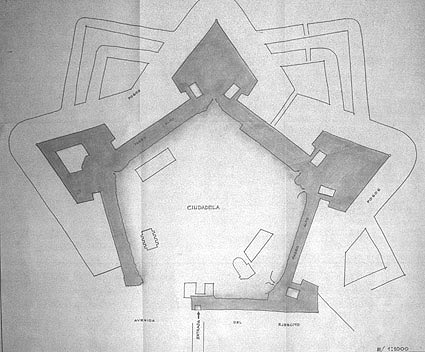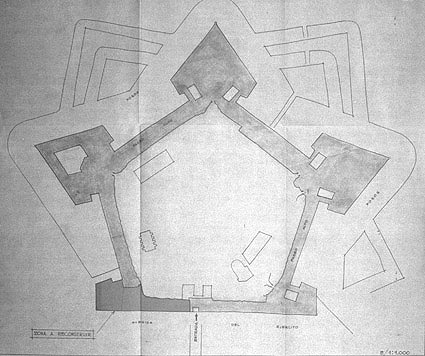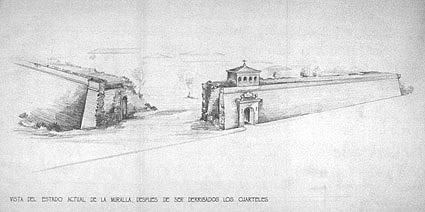Piece of the month December 2006
PROJECTRESTORATION OF THE CITADEL OF PAMPLONA (1970)
Esther Elizalde Marquina
Chairof Navarrese Heritage and Art
The Citadel of Pamplona, "the most distinguished factory in the world", was designed by Philip II, thus replacing the Castle of Ferdinand the Catholic and configured, along with the set of walls, as the main defense of the first bastion of the territory of the Peninsula. Its construction began in 1571 under the supervision of Viceroy Vespasiano Gonzaga and Captain Jacobo Palear Fratín.
However, with the passing of the centuries, the war techniques were modernizing and demonstrating the progressive inefficiency of the Citadel, to which was added the feeling of suffocation motivated by these "old stones" and the need to expand shared by the Pamplona society. Not without much discussion between the Ramo de Guerra and the Pamplona City Council, the creation of the I Ensanche from 1888 meant the mutilation of the Citadel with the annihilation of two of its bastions: the Victoria and San Antón, leading to the loss of the star shape that characterized it. However, this first expansion was insufficient to accommodate the demographic expansion so that, in the early twentieth century, Serapio Esparza projected the second causing the desired demolition of the walls on July 25, 1915. This demolition was desired and celebrated at the time, but later, as the century progressed, it turned towards an incipient defense of the historical and artistic heritage value of Pamplona's fortified enclosure.
Thus, at the end of the 1920s, after an intense discussion in which the Pamplona society was involved, the walls of Pamplona and its Citadel went from being elements to disappear to a symbol and testimony of the history of a city. Thus, the Commission of Historical and Artistic Monuments of Navarre decided to initiate the legal transcript for the declaration of the walls as a National Artistic Treasure Monument in 1928. Eleven years later, they were declared a Historic and Artistic Monument by decree of September 25, 1939, and as such, restoration and beautification work began on both the walls and the Citadel, initially entrusted to the recently created Institución Príncipe de Viana. Later, the monitoring of the walls was entrusted to the Walls Commission created for this purpose in 1950 and made up of members of the Prince of Viana Institution and the Pamplona City Council.
From this decade onwards, a period of restoration work began on the fortified enclosure of the Citadel when it was ceded by the War Department to the City Council on May 21, 1964. With this cession, the aim was to protect it from possible alterations by providing it with a cultural and public recreational purpose, for which the board of trustees the Citadel was formed.

Plan of the citadel of Pamplona after the demolition of the walls
The projectis located in this stage of the enclosure's development. In 1970, work had begun on its total restoration, with the demolition of the buildings of no historical or artistic value that were housed in it. The demolition of one of them, specifically the Infantry Barracks of the America Regiment, led to the disappearance of the wall to which it was attached; this had already been demolished for the construction of barracks for the Regiment's Machine Gun Company. Specifically, it was the stretch of wall facing Avenida del Ejército between the Baluarte de San Antón and the main gate of the Citadel. At the same time, the stones from the demolition of the Infantry Barracks pavilions had emerged from the demolition of 1888. Pamplona City Council therefore acquired these old stones for the reconstruction of the wall exactly as it was in the past.

Plan of the ideal reconstruction of the Citadel Wall
The projectpresented sample shows, on the one hand, the part of the wall to be restored and, on the other, the resultof the work. It can be seen that it was a simple and straightforward project, as it was only necessary to restore the part of the wall marked out in the same way as the wall that was still standing, located to the right of the entranceto the Citadel.
To carry out this work, the City Council requested permission from the board of trusteesof the Citadel and, as it was a national monument, from the Institución Príncipe de Viana. The latter approved the projecton condition that the works were supervised by its technical services and that two rooms inside the fortress were preserved: the dungeon and the Guard Corps, which were accessed through the tunnel from entranceto the Citadel. By way of anecdote, it should be noted that the document to which we refer specifies the dungeon room as the place where the Cuban leader Maceo was imprisoned in 1913.

View of the state of the wall after the demolition of the barracks.
With all this, on 29th July 1970, projectwas approved for the reconstruction work, which began in October of the same year and was completed in June of the following year. The work consisted of the restoration of some 140 metres of wall using 4,500 tons of ashlar stone from the demolition of the bastions of La Victoria and San Antón, for which a budget of 1,977,726 pesetas was earmarked at budget.

projectof the ideal reconstruction of the citadel wall
refundThe importance of this projectlies in the fact that, on the one hand, an attempt was made to restore the Citadel of Pamplona to its original state, as is evident in the use of the ashlars of the old wall, which gave a new appearance to the Avenida del Ejército. It was also one of the first interventions that paved the way for subsequent restorations to achieve the complete recovery of the enclosure as a historical vestige of the Renaissance fortification. From this date onwards, the actions around placewill be multiple and will cease to be specific and will be included in a comprehensive project. All this effort was rewarded with the declaration of the Citadel as a National Historic-Artistic Monument on 8 February 1973.
bibliography:
filePRINCE OF VIANA INSTITUTION.
ECHARRI IRIBARREN, V.: Las murallas y la Ciudadela de Pamplona, Pamplona, Government of Navarre, 2000.
MARTINENA RUIZ, J.J.: La ciudadela de Pamplona, cuatro siglos de una fortaleza inexpugnable, Colección Breve: Temas Pamploneses Pamplona, Pamplona City Council, 1987, vol. 11.
ORDEIG CORSINI, J.M.: designand rules and regulationsen la ordenación urbana de Pamplona (1770-1960), Pamplona, Government of Navarre, departmentde Educationy Cultura, 1992.
